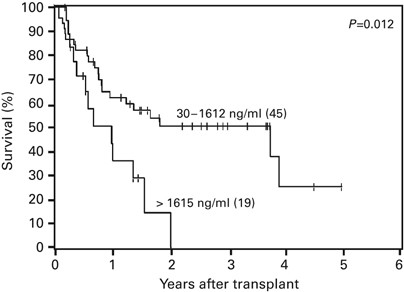
Elevated pretransplant serum ferritin is associated with inferior survival following nonmyeloablative allogeneic transplantation
- Select a language for the TTS:
- UK English Female
- UK English Male
- US English Female
- US English Male
- Australian Female
- Australian Male
- Language selected: (auto detect) - EN
Play all audios:
Iron overload is a well-established adverse prognostic factor for allogeneic hematopoietic SCT in thalassemia,1 and elevated pretransplant serum ferritin seems to adversely affect prognosis
with myeloablative transplantation2, 3 for other diseases as well, primarily because of increased non-relapse mortality. We analyzed patients who underwent nonmyeloablative preparation for
allogeneic transplantation to determine whether the presence of iron overload was also an adverse prognostic factor for patients undergoing nonmyeloablative transplants.
A total of 64 patients undergoing nonmyeloablative allogeneic transplantation for various disorders between 12/00 and 12/06 had pretransplant ferritin levels measured within 100 days
preceding transplantation. Patient and transplant characteristics are summarized in Table 1. Median ferritin was 961 ng/ml (range, 30–6251 ng/ml).
Anyone you share the following link with will be able to read this content: